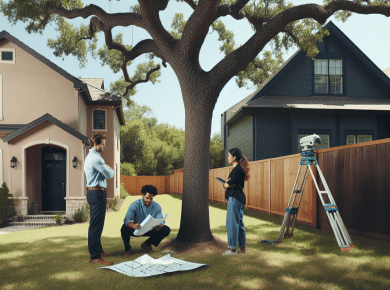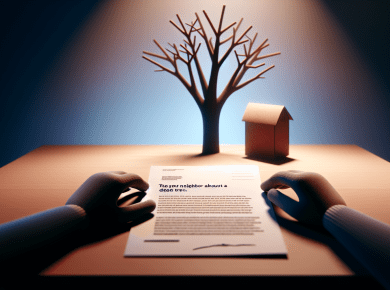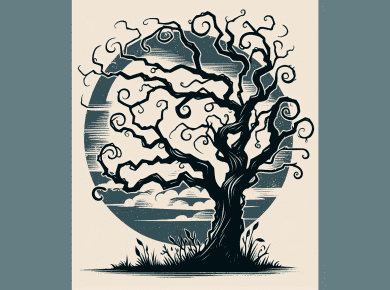Table of Contents
- A neighbor cut down my tree in Minnesota
- My neighbor cut my tree in Minnesota
- My tree branches overhang my property in Minnesota
- My neighbor damaged my tree on my property in Minnesota
- My neighbor’s tree roots or branches damaged my property in Minnesota
- Can my neighbor make me cut my tree?
- How can I get my neighbor to cut his dead tree in Minnesota?
- What happens if I cut my neighbor’s tree down in Minnesota?
- If a tree is cut down on my property by a neighbor how much money should I receive in damages?
- If your property was damaged click here to see if you might have a case.
A neighbor cut down my tree in Minnesota
If your neighbor cut down your tree in Minnesota, unfortunately, recourse through the courts may be the only way to get justice for the damage caused. While the laws surrounding a neighbor cutting down a tree in Minnesota may vary from city to city, generally speaking, if the tree was of significant value, a claim for damages can be made by the injured party.
If the tree was of significant value, the first thing to do is seek legal advice from a lawyer in your area that practices in these cases. Courts in Minnesota generally favor a negotiated settlement over a lengthy hearing, so the advice of the lawyer can be invaluable in crafting a strong settlement agreement.
A lawyer will be able to look at the facts of the case, such as the size and type of the tree, whether it provided valuable shade and other services, and any estimates of the value of the tree. Both parties should agree to an independent appraisal of the tree’s value, as courts in Minnesota will likely consider the opinion of an independent assessor rather than the opinions of parties with a vested interest in the outcome.
The lawyer will then draft a suit and file it in the court. If the claim for damages is successful, the court will issue a judgment for the plaintiff and set out the appropriate damages. Depending on the damage caused, the neighbor may be required to pay reparations for the value of the tree as well as any damage to the property.
If you’re in a situation where a neighbor has cut down your tree in Minnesota, the best course of action is to seek legal advice from a lawyer in your area that practices in these cases.
Don’t be discouraged by the fact that the court may favor a negotiated settlement. With a strong case and the right legal advice, the court will likely award damages in line with the value of your tree.
My neighbor cut my tree in Minnesota
If your neighbor has cut your tree in Minnesota, there are several steps you should take to rectify the situation.
1. Contact them. Start by calmly contacting your neighbor and asking why they have cut down your tree. Explain the potential consequences of their actions and what the process for making it right should be.
2. Research local ordinances. Look into any local ordinances regarding trees that might have been violated by your neighbor. If something is found, contact the legal authorities.
3. Establish a local dispute resolution procedure. Explore ways to settle the dispute without legal action. Depending on the nature of the dispute, this could be anything from processing an informal agreement to a professional mediation.
4. File a civil suit. If the problem can’t be resolved through other means, consider filing a civil lawsuit against your neighbor. Keep in mind, this process can be expensive and time-intensive.
5. Contact a local arborist. Hire an experienced arborist to assess any damage to the tree, as well as any potential liability issues that may arise from the damage.
6. Consider a tree replacement agreement. In some cases, your neighbor may agree to a compensation arrangement that entails replacing the damaged tree.
No matter what course of action you take to address the issue, be sure to do so in a courteous and respectful manner. It’s best to remain calm and refrain from anger, respond positively to any suggestions your neighbor may make, and try to reach an agreement that is beneficial to both parties.
My tree branches overhang my property in Minnesota
Minnesota is full of trees and other forestry that can create a beautiful landscape and provide useful shade in summer months, but when branches and leaves start to overhang your property, they can become a nuisance. In this guide, we’ll explain how to manage branches that overhang your property in Minnesota.
First, you’ll want to determine if the tree is owned by you or the city. If it’s on your property and you are responsible for maintaining it, you should trim the branches or completely remove the tree if it is in a dangerous location or poses a risk to your property. If the tree is owned by the city or public, contact your municipality for assistance.
Once you know who owns the tree, you’ll want to trim the branches yourself or hire a professional. It is important to follow the guidelines outlined by the Minnesota Department of Natural Resources (DNR) as a legal obligation when it comes to trimming and removal. The DNR specifically recommends a tree pruning method that promotes healthy tree structure, shape and benefits all species in the area.
If you decide to hire a professional arborist to take care of the tree, you should make sure you hire one that is licensed, properly insured and experienced in dealing with overhanging branches in Minnesota.
Finally, if you need assistance with debris removal after trimming or removal, contact Fargo’s Waste Management Company to have the accumulated debris recycled or disposed of properly.
No matter the route you take, managing overhanging branches in Minnesota can be a challenging, yet rewarding process. By following these simple steps, you can ensure that your property and the surrounding foliage is kept healthy and beautiful.
My neighbor damaged my tree on my property in Minnesota
If your neighbor has damaged your tree on your property in Minnesota, you may be entitled to compensation. First and foremost, it is important to take photos of the damaged tree and to document the incident. It is also important to consult your local government to see whether or not they have specific guidelines regarding property damage disputes with neighbors.
Next, you should reach out to your neighbor in a friendly and non-confrontational manner to discuss the situation. Ask your neighbor to consider covering the cost of the damage done to your tree. When discussing the matter with your neighbor, it is important to be honest about the damages that have occurred and why reimbursement is necessary. This will help your neighbor understand the seriousness of the situation and should make them more likely to cover the cost.
If your neighbor is unwilling to cover the costs of the damage done, you may have to consider taking legal action. In order to do this, you should make sure that you have documented enough evidence to support your claim, such as photos and receipts. You may also want to consult a legal professional to see what other options are available to you.
Overall, if your neighbor damages your tree on your property in Minnesota, make sure to document the incident and contact the local government to see what options are available to you. It is also important to reach out to your neighbor and to be honest about the damages. If your neighbor is not willing to reimburse you, you can consider taking legal action.
My neighbor’s tree roots or branches damaged my property in Minnesota
Living in Minnesota, you may find yourself living alongside trees and sharing your outdoor space with them. While trees can make a great addition to outdoor spaces, depending on the tree, reaching roots and branches can cause damage to your property. Depending on your specific situation, there are a few steps you can take to remedy the situation.
First, you should contact your local county extension office for help determining the cause of the damage. In some cases, the damage may not be caused by your neighbor’s tree, but instead it is age or weather related. If the damage is related to your neighbor’s tree, you can contact your neighbor directly and explain the issue. Be sure to provide as much detail and evidence as possible. While it may be tempting to demand immediate action, it’s important to approach the conversation with patience and respect.
If your neighbor is unresponsive or unwilling to address the issue, you have several options. You may have to take the legal route and file a nuisance tort complaint, where you could request the neighbor to pay for damages. Your county attorney’s office will likely have additional information regarding this process. Additionally, if damage Cost exceeds a certain threshold, you may be able to file an insurance claim with your property insurer.
If all else fails, you may need to consult with a lawyer to explore additional legal remedies. This can be costly and time intensive, so it’s usually a last resort.
No matter what issue you may be dealing with, it can be helpful to do your own research and contact a specialist or professional for help or advice. You can also reach out to your county extension office for additional resources specific to Minnesota that may provide additional guidance.
Can my neighbor make me cut my tree?
If you’re living on a plot of land that’s close to your neighbor’s property, you might be wondering if they can make you cut down any trees on your property. The answer depends on how the property is zoned, state laws, and if the tree is a nuisance.
First, you need to determine if the tree is a nuisance. If the tree is damaging your neighbor’s property, creating hazardous conditions, or otherwise negatively impacting their property or land, then your neighbor may have a legal case against you. If the tree is causing all or some of these, then the neighbor can sue you to make you trim, remove, or replace the tree.
Next, you need to find out if the properties or the tree are impacted by the city’s zoning regulations. If the tree is within the city limits, then the city may have rules that designate whether or not the tree can be removed. Generally, any tree that is a nuisance, damaging other properties, or otherwise impacting the neighbors land can be removed or trimmed according to the zoning regulations.
Finally, the state’s government may also regulate how the tree should be dealt with. Many states have laws in place that regulate how close you can be to your neighbor’s property and what type of trees can be removed. Additionally, some states may require formal mediation if the tree is causing damage or creating a nuisance.
In the end, it’s important to know the laws and regulations of your state and city. If your neighbor’s tree is causing a nuisance or damaging their property, then they may have the legal right to make you trim, remove, or replace it.
How can I get my neighbor to cut his dead tree in Minnesota?
If your neighbor in Minnesota has a dead tree in their yard, you should address it with them as soon as possible. Falling trees can be dangerous, and dead trees can cause property damage and introduce disease to healthy trees.
1. Talk to your neighbor. Have an open and honest dialogue to express your concern about the dead tree before assuming that your neighbor is negligent. It may be that your neighbor is not aware of the situation and genuinely would like to take care of the dead tree.
2. Observe the tree for signs of infestation or other damage. If you discover any dead branches, insects, or molds, take a photo and present it as part of your case.
3. Contact a certified arborist. Request an inspection of the dead tree, and be sure to have a written estimate of the cost of removing and disposing of the tree. Include a statement of the safety hazards and health hazards associated with the dead tree.
4. Make a request and provide options. Present your evidence to your neighbor in writing. Offer options to remove the tree, such as assuring them that you will cover the cost or volunteering to help them with the removal.
5. Check local ordinances. Some municipalities may have regulations regarding dead trees that you and your neighbor are required to follow.
By following a few steps and staying calm, you should be able to get your neighbor to take action to remove the dead tree in Minnesota.
What happens if I cut my neighbor’s tree down in Minnesota?
In Minnesota, it’s illegal to cut down a neighbor’s tree unless you’ve gotten permission from them or the local government to do so. If you cut down a neighbor’s tree without permission, then you could be charged with vandalism, which is a misdemeanor crime. Depending on the size of the tree and the cost to replace it, you could be facing punishment including a fine of up to $1000 and/or a maximum six months of jail time.
Additionally, even if you did have permission to cut down the tree, you could still be held responsible for any damages caused to the neighbor’s property if you do not take appropriate safety measures.
If you do proceed with cutting down the tree, you should always take safety precautions such as using the right tools, wearing protective gear, and taking the proper steps to properly remove the tree without damaging the neighbor’s property.
If you damage the neighboring property, you may be held liable for any repairs needed. Depending on the extent of the damage and resulting repair costs, you could be facing legal action by the neighbor.
The best way to avoid legal consequences is to get written permission from your neighbor or the local government before cutting down a tree. If you do not have permission, it is illegal and you could be held liable for your actions.
If a tree is cut down on my property by a neighbor how much money should I receive in damages?
If a tree on your property was cut down by a neighbor in Minnesota, the owner of the tree can file a lawsuit asking for money damages. Minnesota is a strict liability state, so the neighbor who cut down the tree will have to pay damages. However, if you are looking to sell your house and your real estate agent tells you that you need to remove a tree on your property, you can’t sue if the neighbor acts faster than you do and removes the tree.
Damages would be determined by the value of the tree and how much it would cost to replace it. If it was an old oak tree that could be sold for lumber, for example, you might get more money than if it were just a sapling.



